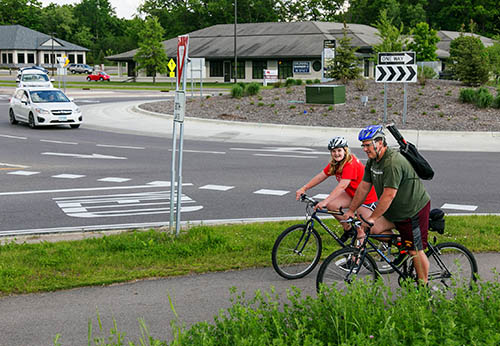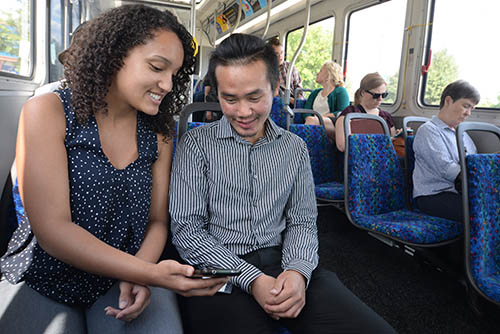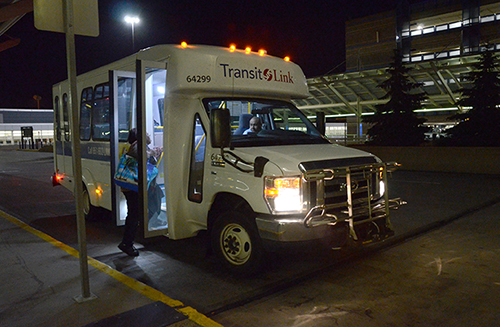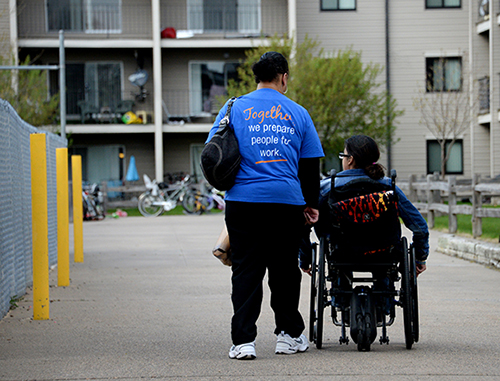 When you gather travel data from nearly 8,000 households, over a year’s time and across 19 counties — the seven-county metro area and 12 neighboring Minnesota and Wisconsin counties — you start to get a complete picture of the way people travel in and around the Twin Cities metropolitan area.
When you gather travel data from nearly 8,000 households, over a year’s time and across 19 counties — the seven-county metro area and 12 neighboring Minnesota and Wisconsin counties — you start to get a complete picture of the way people travel in and around the Twin Cities metropolitan area.
The Travel Behavior Inventory household survey went into the field in October 2018 and asked households to collect data over seven days using a smartphone app. A majority of the respondents did just that, averaging six out of seven days tracked, capturing weekend travel behavior that we’ve never collected in previous surveys.
By October 2019, when the survey closed, the Met Council had collected a rich dataset of travel in and around the region. “We want to do additional specific statistical analyses and explorations to understand more about how people get around in the region,” said Ashley Asmus, a data scientist with Metropolitan Transportation Services.
 In the meantime, here are some high-level results to provide a snapshot of what is to come:
In the meantime, here are some high-level results to provide a snapshot of what is to come:
-
7,870 households surveyed
-
5,366 responded using smartphone app (for one week)
-
2,504 used a one-day diary survey
-
23% rent their home, 75% own
-
7% with no vehicle
-
Total of 16,222 people (2.1 people per household)
Trips taken: 350,638
The household survey data reveals some fun and fascinating trips, according to Asmus. “Someone took their smart phone and got cell phone service the whole time they were hiking up Machu Picchu,” she said. Add to that a quick trip to the Cayman Islands and you can start to see the stories that the data can tell us.
“There’s a lot of really rich information that people told us about why they were traveling that really reveals the fullness of life in the metro area,” Asmus said.
Health care, shopping, and other errands are the biggest share of trips
However, the day-to-day lives of most Minnesotans aren’t quite so glamorous. These travel data represent the majority of what many, prior to our current COVID-19 outbreak, would classify as the ordinary passage of everyday living.
-
40% Maintenance trips
-
Trips for healthcare
-
Shopping (grocery, pharmacy, household items)
-
Errands
-
Picking up and dropping off family members
-
29% Social/Recreational
-
24% Work
-
5% + for School
 Travel to work isn’t all during rush hour
Travel to work isn’t all during rush hour
Many people think about commuting to work during the busiest and most typical rush hour times between 7:30 to 8:30 a.m. and 4 to 5:30 p.m. The data in the household survey remind us that essential travel to work also happens in the middle of the day by people who do shift work from 3 to 11 p.m. or 1 to 9 p.m.
“This kind of data can be informative in planning transit services or helping make our transportation systems work equitably for people who work all sorts of jobs,” said Asmus.
Another interesting point comes from the data about transit commutes. Across all income levels, the median transit commute (39 minutes) is about 56% longer than driving (25 minutes).
Transit trips for groceries take more time
Groceries and grocery stores are certainly top of mind during the outbreak. Across the time of this survey, the data shows us that there are disparities in making this essential trip.
If a person drives, walks, or rides a bicycle, a trip to the grocery store takes about 12 minutes. If a person takes transit, the median time to get there is about 25 minutes. “If you think about it, that’s a lot of time lost if you travel to and from — about half an hour,” said Asmus.
Of those who took transit to the grocery store, 18% were African-American, compared with 3% of those who drove, 9% of those who walked, and 3% of those who biked.
Social and recreational travel goes up on weekends
With the results of this survey, we are just starting to scratch the surface of weekend travel. As expected, weekend travel differs from weekday travel, but perhaps not in all areas.
Not surprisingly, school and work trips still happen on the weekends, although at a much lower rate, and social and recreational travel increases dramatically. Shopping and errands, however, appear to hold constant between weekdays and the weekend.
Some people report taking no trips
Some people in our survey did not travel at all. Even this data point is important because it helps reveal barriers to travel or the reasons people choose not to go somewhere.
On a typical weekday in the metro, 17% of people do not travel.
-
36% were doing housework (48% female; 45% male)
-
3% were taking care of children (52% female; 37% male)
-
16% because of weather (78% in Jan/Feb 2019)
-
10% were working remotely
-
6% lacked transportation
Travel reflects who we are, what we do
The makeup of the people who participated in the survey also shows us travel patterns by demographic and socioeconomic characteristics.
 Gender roles translate into travel differences
Gender roles translate into travel differences
Women under age 65 take a lot more trips than men to serve their family and transport others to and from school/appointments, and they take fewer trips for work. And, interestingly, that seems to flip when people reach 65.
People who have a disability take fewer trips
For a person who has a physical disability that impacts travel outside the home, that person takes about one less trip per day. The data also show that disability-related disparities in travel are greatest for work and for social travel, and greatest for older adults versus younger adults.
Digging in deeper on race/ethnicity
Effective and fair decision-making requires data that accurately represents or reflects the population in the study area. The study design took three key actions to improve representation among historically underrepresented populations:
-
Oversampling hard-to-reach groups to increase participation
-
Outreach to encourage participation
-
Reminders to encourage full completion of the survey
Overall, the data show some evidence of disparities in travel by race and ethnicity, especially in social/recreational and shopping/errand trips. The Met Council will be conducting analyses to understand these disparities more completely in the context of life in the metro area.
We also want to know, for example, how the types of jobs that people have are impacted by whether people get around by car or by transit. Travel patterns are incredibly varied, and in order to get the complete picture of people’s transportation needs, more in-depth analysis is needed.
Background on the survey
In 2018-2019, the Met Council surveyed more than 7,500 households across the region to understand how they travel around the Twin Cities and surrounding areas. This survey was conducted in partnership with the Minnesota and Wisconsin Departments of Transportation.
The study ran from October 2018 through September 2019. Participant households were randomly selected from 19 counties throughout the greater Twin Cities region, including the seven-county metro area and three Wisconsin counties.
The Met Council transitioned the household survey to collecting data every other year instead of every 10 years, asking participants to use a smartphone application for seven days, or choose a one-day travel survey submitted online or over the phone.
The survey data and reports will help agencies propose practical transportation investments, produce competitive federal grant applications, and prioritize the improvements that best fit regional needs. These data will be released throughout 2020.
Travel Behavior Inventory Data Highlights (PDF)